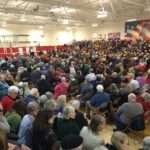
New Harmony is a picturesque historic town on the Wabash River in Posey County, Indiana, and if you are anywhere nearby, you absolutely should take a day to visit. I grew up in Henderson, Kentucky, and I had never been until last month, almost 40 years after moving away – embarrassing, because it’s so close by! It’s about 26 miles from Evansville, Indiana. It’s midway between St. Louis, Missouri and Louisville, Kentucky.
The best days to go, IMO, are Wednesday, Thursday, Friday, Saturday or Sunday – lots of businesses are closed Monday and Tuesday. Go in dry weather, because you will spend a lot of time outside.
The town is filled with beautifully-preserved houses and buildings from the 1800s. I highly recommend renting a golf cart outside the Atheneum, the large white modern building next to the Wabash River at the edge of town, to tour the town. Get a map while you are there or download one on your phone.
Understanding the history will help you appreciate the town even more:
New Harmony was established by the Harmony Society in 1814 and was originally known as Harmony (also called Harmonie, or New Harmony). It was a settlement for a group of German Lutherans who had separated from the official church in Württemberg and immigrated to the USA. They were nonviolent pacifists who refused to serve in the military and tried to live by George Rapp’s philosophy and literal interpretations of the New Testament. The Harmonites believed Jesus Christ was coming to earth in their lifetime to help usher in a thousand-year kingdom of peace on earth. They believed that the old ways of life on earth were coming to an end and that a new perfect kingdom on earth was about to be realized.
The Harmonites believed that people should try to make themselves “pure” and “perfect”, and share things with others while willingly living in communal “harmony” (Acts 4:32-35) and practicing chastity. The Harmonites tended to view unmarried celibate life as morally superior to marriage, based on Rapp’s belief that God had originally created Adam as a dual being with both male and female sexual organs. According to this view, when the female portion of Adam separated to form Eve, disharmony followed, but one could attempt to regain harmony through celibacy. Rapp often spoke of the virgin spirit or Goddess named Sophia in his writings. The Hamonites built 180 buildings in the 10 years and many are still standing today. They produced textiles, rope, barrels, tin ware, leather goods, candles, bricks, wine, whiskey and beer. Read about the Harmonites at the Harmony_Society entry on Wikipedia.
But what I am MUCH more interested is what happened after that settlement failed and was sold to Robert Owen, a social reformer and wealthy industrialist from Scotland. Owen’s vision was for “a New Moral World” of happiness, enlightenment, and prosperity through education, science, technology, and communal living. Per the call of Owen inviting others to come be a part of his intentional community, in the winter of 1825–1826, the president, librarian, and several members of the Philadelphia Academy of Sciences headed west from Pittsburgh on the Ohio River to New Harmony. Academy President William Maclure, “father of American geology,” had gathered them all aboard the keelboat Philantropist [they used the French spelling]: scientists, artists, musicians, and educators, some bringing along their students, and all eager to settle in New Harmony on the Indiana frontier. Owen described it as a “Boatload of Knowledge.”
This New Harmony was very different from the original founders: the community provided free co-educational schooling for children from infancy to adulthood half a century before the state mandated it. Town residents also established the first public library and a civic drama club. Among its prominent citizens was one of Owen’s sons, Robert Dale Owen, an Indiana congressman and social reformer who sponsored legislation to create the Smithsonian Institution. It was a bold, glorious experiment in communal living with a focus on learning, on the arts and on science. But like pretty much every communal experiment in the USA, most of which were religious-based, the town failed as a utopia – in this case, because of disputes over who had power and influence and who didn’t, as well as philosophic disputes. New Harmony was dissolved in 1829 and the town’s parcels of land and property were returned to private use. But although Robert Owen’s vision of New Harmony as an advance in social reform was not realized, the town became a scientific center of national significance, especially in the natural sciences, most notably geology. And the soul of the town continued through the work of many of its residents, including Robert Dale Owen, eldest son of Robert Owen: in 1830 he published Moral Philosophy, the first treatise in the United States to support birth control, and he returned to New Harmony in 1834.
With this history in mind, going into the Working Men’s Institute – part library, part museum, part memorial to a Utopian dream – is a must.
You should also go into any building or business that’s open during your visit, like Community House No. 2, any historic church, whatever. If there is a tour of the town being offered that takes you into houses or buildings, take it! If you hear music coming from a building and the door is open, go in!
Go into Creation Station 310 and behold the gorgeous dulcimers available for sale – and stay if the owner is playing one! He may even show you how to play one (he did with me!). Visiting Creation Station 310 was the highlight of our entire visit.
Give yourself time for a hike or a ride on your golf cart on the trails from the open-air church to the Atheneum.
If the Roofless Church is having a service, and it’s a beautiful day, I would think that would be a worthwhile experience, regardless of your religion (or, like me, lack their of).
I wasn’t that impressed with the labyrinth, I must admit. I love the symbolism of it, but actually seeing it didn’t really do anything for me. Apparently, for the original founders of the town, the Harmonists, the labyrinth symbolized the difficulties of attaining true harmony and the choices one faces in life trying to reach that goal. The labyrinth was a place of meditation for the Harmonists. Maybe if the shrubs had been full of leaves and had been higher… but I did find it interesting that the labyrinth was so important to the Harmonists, they of the Christian faith, rather than the scientifically-focused settlers who came later.
There are also a lot of antique shops, including a record store, and some food options in beautiful settings. Christmas is a very big deal for the town.
You can do everything in a day… but if you are looking to stay overnight, there is Harmonie State Park nearby, which has cabins, as well as some picturesque guest houses.
The Visit New Harmony official web site has complete info on where you can stay, eat, shop, tour, etc.
You can see all of my photos from my November 2023 visit to New Harmony here. I loved the town so much, I’ve been joking with my friends that it’s where we should all move when we retire, to create the second attempt at a science and arts-focused learning utopia there. But… am I really joking?













Leave a Reply